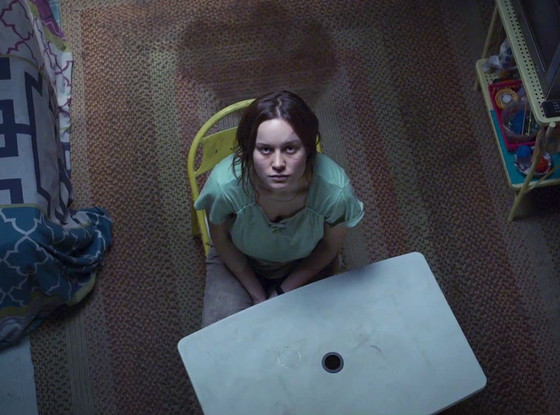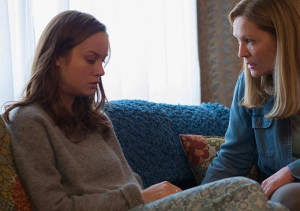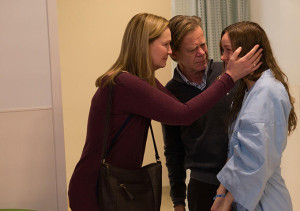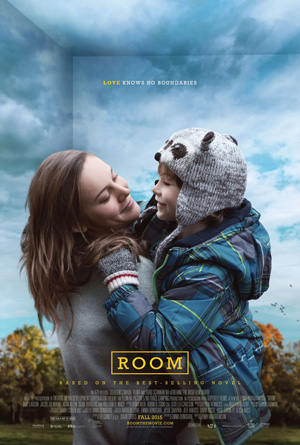Andrew Rostan was a film student before he realized that making comics was his horrible destiny, and he’s never shaken his love of cinema. Every week, he’ll opine on current pictures or important movies from the past.
There are many words to describe Room, adapted by Emma Donoghue from her novel and directed by Lenny Abrahamson, but if I had to sum it up in only one, that word would be “still.” Room is a quiet, lingering, peaceful movie for the most part, and this tone serves to both make the moments of emotional crescendo all the more hard-hitting and allow the audience to enter the characters’ emotional states in the midst of the calm, thus allowing the story’s drama and power to overwhelm. Room is an unforgettable picture, and while credit is due to the entire team, the greatest masterstroke is the performance of Brie Larson.
The Center of the Galaxy
 If Room is still, then Larson’s Ma is the stillest of the still. From the opening scenes, Ma projects a rarely-failing calm. Her body moves at the barest minimum, and her face is mainly expressionless. But this is the opposite of blankness or the “resting bitch face.” Ma conveys in every frame, through subtle changes in her eyes, her posture, and her other physical traits, a silent intelligence and a swirling galaxy of conflicting emotions inside her. The enduring stillness serves a purpose: for Ma to protect her son Jack, whose fifth birthday commences the film, from his father and their captor, and be the strong presence who can inspire their survival and escape. This quality is most apparent when Ma tells Jack about the outside world and how she ended up in Room: it is a harrowing narrative that leaves dark thoughts in the imagination, but Ma/Larson is collected, even wryly smiling at a memory of defeat, and where that calmness comes from and why she has to smile are intelligible to we who have seen her endure the “bad tooth” that rots out of her mouth, the bruises, and the repeated assault.
If Room is still, then Larson’s Ma is the stillest of the still. From the opening scenes, Ma projects a rarely-failing calm. Her body moves at the barest minimum, and her face is mainly expressionless. But this is the opposite of blankness or the “resting bitch face.” Ma conveys in every frame, through subtle changes in her eyes, her posture, and her other physical traits, a silent intelligence and a swirling galaxy of conflicting emotions inside her. The enduring stillness serves a purpose: for Ma to protect her son Jack, whose fifth birthday commences the film, from his father and their captor, and be the strong presence who can inspire their survival and escape. This quality is most apparent when Ma tells Jack about the outside world and how she ended up in Room: it is a harrowing narrative that leaves dark thoughts in the imagination, but Ma/Larson is collected, even wryly smiling at a memory of defeat, and where that calmness comes from and why she has to smile are intelligible to we who have seen her endure the “bad tooth” that rots out of her mouth, the bruises, and the repeated assault.
 Room is not entirely Ma’s story but she is the one who suffers most, and the effect of her experience is what powers Donoghue’s brilliantly constructed story. The film splits almost neatly in half, the first part telling of Ma and Jack’s final days in Room and the second of their adjustment to the outside world, and that second part is a far cry from Kimmy Schmidt’s adventures. Ma is every bit as unbreakable but the enduring stillness does not leave her, for now her resilience and quiet force are her nature…until another of the film’s great scenes, when Ma is interviewed for the national news and the interviewer asks a provocative question. Leigh, who saw the film with me, described it as the moment when we feel “her pain, her anger, and her world falling apart” in full force, and this change pushes the movie to its conclusion.
Room is not entirely Ma’s story but she is the one who suffers most, and the effect of her experience is what powers Donoghue’s brilliantly constructed story. The film splits almost neatly in half, the first part telling of Ma and Jack’s final days in Room and the second of their adjustment to the outside world, and that second part is a far cry from Kimmy Schmidt’s adventures. Ma is every bit as unbreakable but the enduring stillness does not leave her, for now her resilience and quiet force are her nature…until another of the film’s great scenes, when Ma is interviewed for the national news and the interviewer asks a provocative question. Leigh, who saw the film with me, described it as the moment when we feel “her pain, her anger, and her world falling apart” in full force, and this change pushes the movie to its conclusion.
All of this is in large part due to Larson. She gives a wise, weighty, deeply felt performance without melodrama or artifice. She becomes Ma the same way Daniel Day-Lewis and Meryl Streep become their characters when they are at the height of their powers. And when I think of how she is only 26, the all-but-perfection of her work only increases in its ability to startle.
The Other Perspectives
 Room puts Ma through the weightiest dramatic arc, but Donoghue and Abrahamson tell the story, in one of several wise choices, from Jack’s perspective. Jacob Tremblay, who was eight when Room was filmed, is outstanding. It speaks volumes to how effective the picture is that my fascination with Larson was matched by Leigh’s fascination with Tremblay, who she described to me as filling the movie with “lightness and hope and little humorous moments:” the counterbalance to the rest of the story. This sense of joy comes from an unforced confidence and playfulness in Tremblay that never becomes precious. He acts like a normal five year-old making sense of the world around him—indeed, making sense of two different worlds—and conveys all the highs and lows involved. A wonderful and ultimately poignant moment which Leigh singled out is Jack’s habit of saying hello to all the furniture in Room: through the movie, as soon as Jack finds comfort in something or someone, he loyally embraces that source, and this attitude provides the uplift needed.
Room puts Ma through the weightiest dramatic arc, but Donoghue and Abrahamson tell the story, in one of several wise choices, from Jack’s perspective. Jacob Tremblay, who was eight when Room was filmed, is outstanding. It speaks volumes to how effective the picture is that my fascination with Larson was matched by Leigh’s fascination with Tremblay, who she described to me as filling the movie with “lightness and hope and little humorous moments:” the counterbalance to the rest of the story. This sense of joy comes from an unforced confidence and playfulness in Tremblay that never becomes precious. He acts like a normal five year-old making sense of the world around him—indeed, making sense of two different worlds—and conveys all the highs and lows involved. A wonderful and ultimately poignant moment which Leigh singled out is Jack’s habit of saying hello to all the furniture in Room: through the movie, as soon as Jack finds comfort in something or someone, he loyally embraces that source, and this attitude provides the uplift needed.
 Each half of the film also has a different supporting cast. In the first part, Deadwood alumnus Sean Bridgers is seen relatively little as Old Nick but captures his twisted, sadistic loneliness and the horror that comes from it. Nick disappears from the story in the second part after Ma and Jack escape from Room, another wise choice as it leads to complete focus on the two victims’ reintegration into the outside world. That world is represented by Joan Allen and William H. Macy as Ma’s parents Nancy and Robert and Tom McCamus as Leo the “family friend.” None of them have any big speeches or center-stage moments. All of them are perfect. Macy conveys a defeated desolation in only three minutes of screen time. Allen is the strong and loving pillar attempting to hold things together, a role which she understands requires little talking and lots of fortitude, and the always-welcome actress shows these emotions so well that the mother-daughter relationship of Nancy and Ma is fully believable. McCamus is the film’s secret weapon, playing Leo with a sense of unconditional love and charisma needed to help push the story to its ending, and doing so in a way that suggests the kind of man Jack will grow into.
Each half of the film also has a different supporting cast. In the first part, Deadwood alumnus Sean Bridgers is seen relatively little as Old Nick but captures his twisted, sadistic loneliness and the horror that comes from it. Nick disappears from the story in the second part after Ma and Jack escape from Room, another wise choice as it leads to complete focus on the two victims’ reintegration into the outside world. That world is represented by Joan Allen and William H. Macy as Ma’s parents Nancy and Robert and Tom McCamus as Leo the “family friend.” None of them have any big speeches or center-stage moments. All of them are perfect. Macy conveys a defeated desolation in only three minutes of screen time. Allen is the strong and loving pillar attempting to hold things together, a role which she understands requires little talking and lots of fortitude, and the always-welcome actress shows these emotions so well that the mother-daughter relationship of Nancy and Ma is fully believable. McCamus is the film’s secret weapon, playing Leo with a sense of unconditional love and charisma needed to help push the story to its ending, and doing so in a way that suggests the kind of man Jack will grow into.
The Production: The Room and Beyond
Room is Abrahamson’s second major feature after a string of well-received indie films in his native Ireland and last year’s off-kilter comedy Frank. He is the ideal director for this picture because he embraces all its intimate aspects in ways that go beyond giving the actors the creative freedom needed to develop their roles. Abrahamson and his production designers Ethan Tobman and Michelle Lannon create Room as a place so well laid-out and full of the right objects that it seems as giant and full of possibility as Jack sees it. When the movie takes Ma’s childhood home as its primary setting, Abrahamson luxuriates in nooks and crannies and staircases, reveling in the tight spaces of the outside world as much as he did in Room. Danny Cohen’s cinematography is similarly well-defined, and Stephen Rennicks, a longtime collaborator of Abrahmson’s, creates a tear-inducing neo-classical score, dominated by strings and waltzes, that fits the bitterness and sweetness of the tale.
The concluding point of all of the above is that Room is a movie where all the pieces, from the acting to the script to the production elements, are executed with something close to flawlessness. Donoghue and Abrahamson’s storytelling never overreaches its bounds and suggests even more than it narrates, and the result is a film that works as high cinematic art and another of this year’s great testaments to the human spirit. The difference is that Mad Max and Furiosa found their victory in the most unbelievable car chase ever and Mark Watney single-handedly survived on Mars. Ma, as enacted by Brie Larson, is a reminder to all of us that the human spirit’s best triumphs so often come not with action and adventure, but resilient stillness in the face of the most trying circumstances. And that is a message I am moved to see delivered so well.
Room is in cinemas. Pictures from Movienewz, E!, Indiewire, and CBC.





